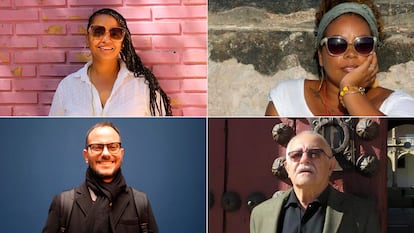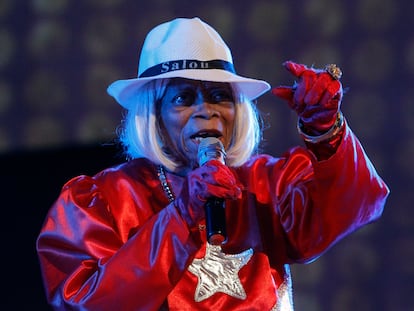Cuban dissident intellectuals prefer Madrid to Miami
Never before have so many Cubans lived in Spain, which now has 200,000 residents from the Caribbean country, 10% of whom live in the capital

Madrid has become a favorite destination for many exiled Cuban artists and intellectuals who are looking for a space from where they can continue their political activism. The proof is that there have never been so many Cubans living in the Madrid region as there are now. Ten percent of the 200,000 Cubans living in Spain are in the capital, according to the latest data available from the National Statistics Institute (INE). Among them, many activists, artists and intellectuals who have been forced to leave their homeland like communicator María Matienzo, 45, who arrived in the city a year and a half ago.
“Since 2019, I suffered systematic political persecution for the journalistic work I was doing. There came a point when I couldn’t take it anymore and I had to ask for help from international organizations to leave the island,” says Matienzo, who first traveled to Argentina, but there she felt very lonely. “There was no community of Cubans with whom I could share. So I decided to migrate to Spain.”
In Madrid she has been able to find her place. “What better place to live than where the friends of struggle are,” assures the communicator, who speaks nostalgically of her situation. “I can’t go back. We have received threatening messages through our relatives warning me that if I go back, I could go to prison,” she adds.
Cuban artists, intellectuals and activists have formed a community here on the other side of the Atlantic. “Although Miami is still the most recurrent option when it comes to migrating, for the past five years the tightening of visas has made more and more people prefer Spain,” explains Matienzo.
Three years ago, on July 11, 2021, thousands of people took to the streets in Cuba to demand political change. These demonstrations were encouraged by the rise of the San Isidro Movement, a group of artists who were repressed by the Havana regime during a collective hunger strike in late November 2020. Since then, the situation on the island has hardened for the people who participated in these protests. Many of them have opted for exile.
While hundreds of thousands sought ways to get to the United States, the promised land just over 140 kilometers (87 miles) away on the coast of Florida, many of the people of the theater, film, and visual arts world set sail for Madrid. The language, the ease of obtaining a visa, the support networks, and the welcome programs for dissidents are the reasons why many Cubans opt for the Spanish capital. “We have found a community that has embraced us. Here, no Cuban will leave you alone sleeping in Atocha (railway station),” Matienzo says.
Leonardo Fernández, 32, is studying for a doctorate at the University of Alcalá de Henares and has been working at the Global Observatory of Academic Freedom since 2022, when he was forced to leave Cuba by the government. “After suffering a process of academic censorship, I was expelled from the university. My whole family was harassed, repressed, and interrogated because I participated in the July 11 protests and was linked to cultural dissidence movements, which made me a target of the regime,” he says.
For Fernández, the choice to come to Spain was an easy one: “I had many connections with other Cubans who are living in Madrid, and we have created a great community in Alcalá of very well-educated personalities. This is the closest thing to home. Deep down, we have a very interesting connection with Spain because we were its last colony,” he recalls. “You have to understand the nature of exiles. Miami is a place of entrepreneurs; intellectuals who want to continue their education have come here.”
Sandra del Valle, 40, is a cultural researcher and film producer. She does not feel part of any dissidence, although she left Cuba 15 years ago and, after passing through four countries, has ended up in Madrid, where she says she has found the closest thing to home since leaving the island: “I am part of a generation that has decided to explore the world beyond the United States,” she says.
Del Valle has been in the capital for a year and explains that she has adapted well because there is a very strong community of Cubans. Yanelys Núñez Leiva, 35, who works as an art historian, agrees. “I was expelled from my country for founding the Museum of Dissidence in Cuba. I left with the excuse of attending a workshop in Prague and decided to migrate to Madrid,” she says, although she remains closely linked to the San Isidro Movement. From Spain, she works monitoring the femicides that occur on the island. “We have held several demonstrations in Madrid to continue the struggle,” she says.
For Núñez Leiva, the fact that Madrid has become the epicenter of the migration of dissident Cuban artists holds a very simple explanation. “It’s much easier for this sector of the population to get a work visa,” she says, stating that the community that has arrived in the city are Cubans committed to pushing for change in their country from exile.
The link between Cuban dissidents and Spain goes back a long way. Pío E. Serrano, 83, arrived in Madrid in 1974 and has been able to witness how after his migration there has been a succession of exiles across generations. “Each one has a different story, with particular human characteristics of exile that go hand-in-hand with the transformation that the regime has undergone,” he says.
Fifty years ago he decided to live in Spain because, at that time, there was only one exit route from Cuba by air, and that was Madrid. “I didn’t like coming to a dictatorship like Franco’s, but here I discovered a resistance movement that got me hooked,” he recalls. At that moment, he set out to see the end of Franco’s regime just as he had seen the beginning of the revolution in Cuba.
The Cuban colony that began to be created from Serrano’s generation is now responsible for creating a support network for Cubans, who are arriving with increasing frequency. “Very young but committed people are arriving, with very clear ideas. Many of them are very well-trained artists,” he says.
Sign up for our weekly newsletter to get more English-language news coverage from EL PAÍS USA Edition
Tu suscripción se está usando en otro dispositivo
¿Quieres añadir otro usuario a tu suscripción?
Si continúas leyendo en este dispositivo, no se podrá leer en el otro.
FlechaTu suscripción se está usando en otro dispositivo y solo puedes acceder a EL PAÍS desde un dispositivo a la vez.
Si quieres compartir tu cuenta, cambia tu suscripción a la modalidad Premium, así podrás añadir otro usuario. Cada uno accederá con su propia cuenta de email, lo que os permitirá personalizar vuestra experiencia en EL PAÍS.
¿Tienes una suscripción de empresa? Accede aquí para contratar más cuentas.
En el caso de no saber quién está usando tu cuenta, te recomendamos cambiar tu contraseña aquí.
Si decides continuar compartiendo tu cuenta, este mensaje se mostrará en tu dispositivo y en el de la otra persona que está usando tu cuenta de forma indefinida, afectando a tu experiencia de lectura. Puedes consultar aquí los términos y condiciones de la suscripción digital.
More information
Archived In
Últimas noticias
Most viewed
- Reinhard Genzel, Nobel laureate in physics: ‘One-minute videos will never give you the truth’
- Oona Chaplin: ‘I told James Cameron that I was living in a treehouse and starting a permaculture project with a friend’
- Pablo Escobar’s hippos: A serious environmental problem, 40 years on
- Why we lost the habit of sleeping in two segments and how that changed our sense of time
- Chevy Chase, the beloved comedian who was a monster off camera: ‘Not everyone hated him, just the people who’ve worked with him’











































